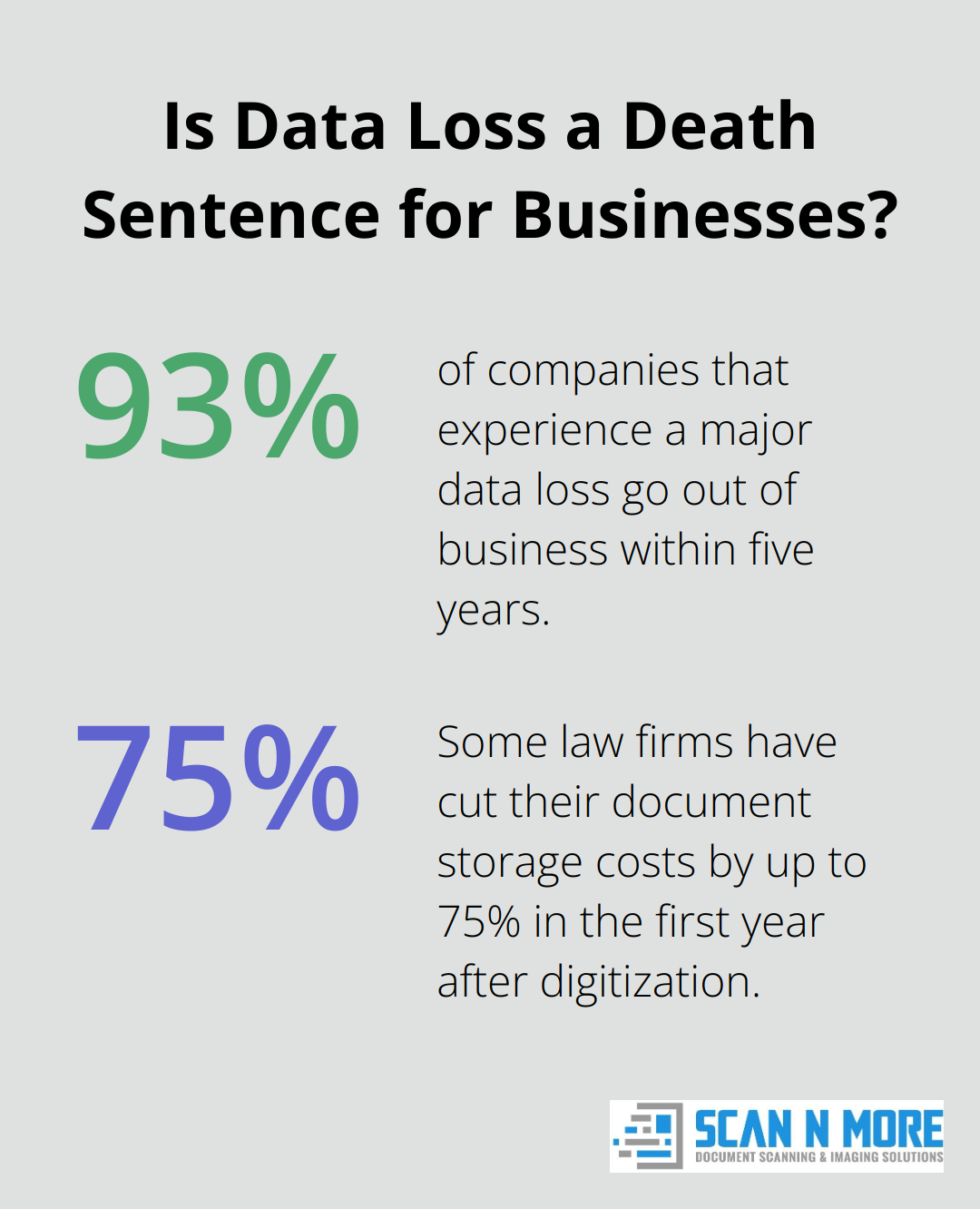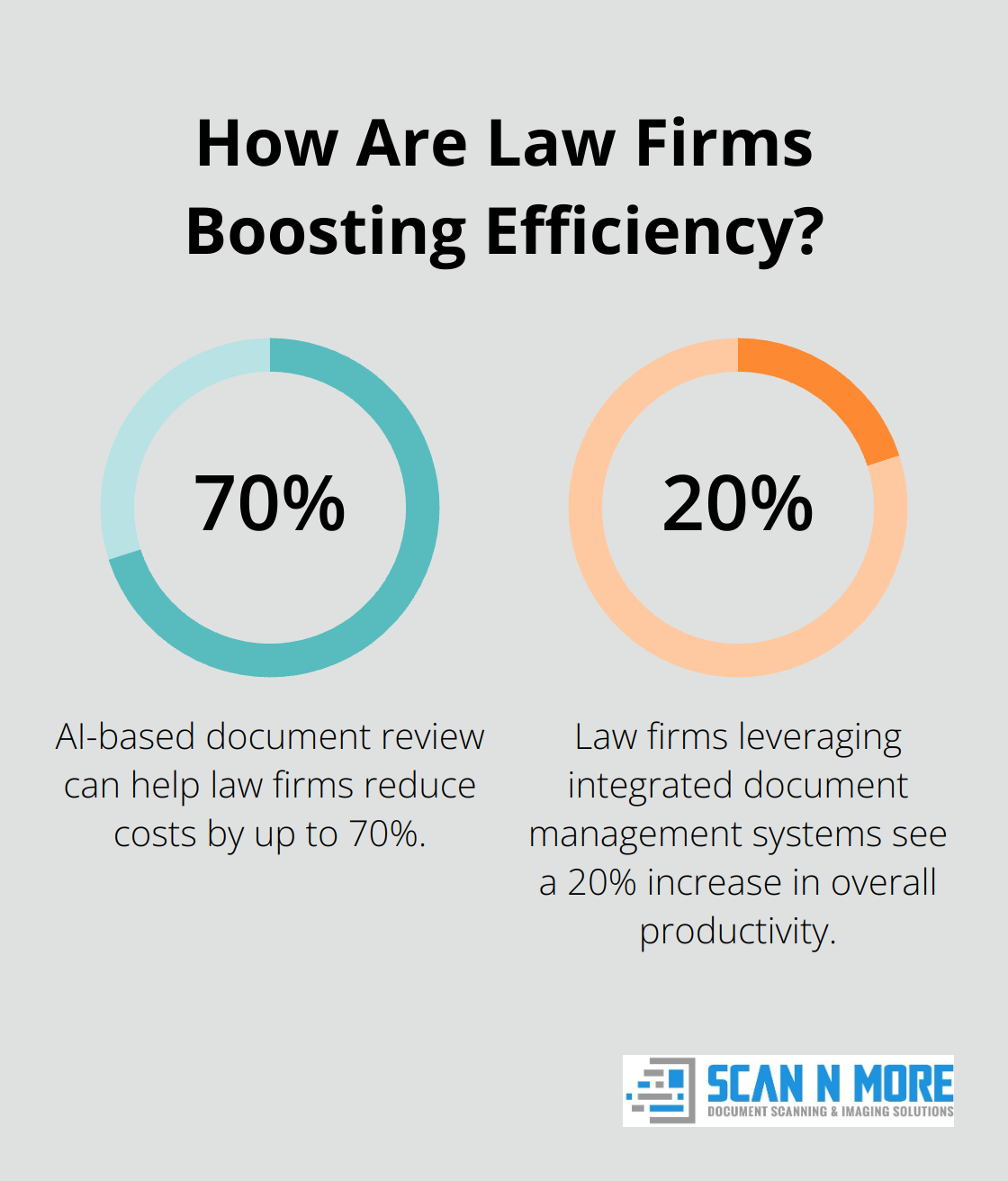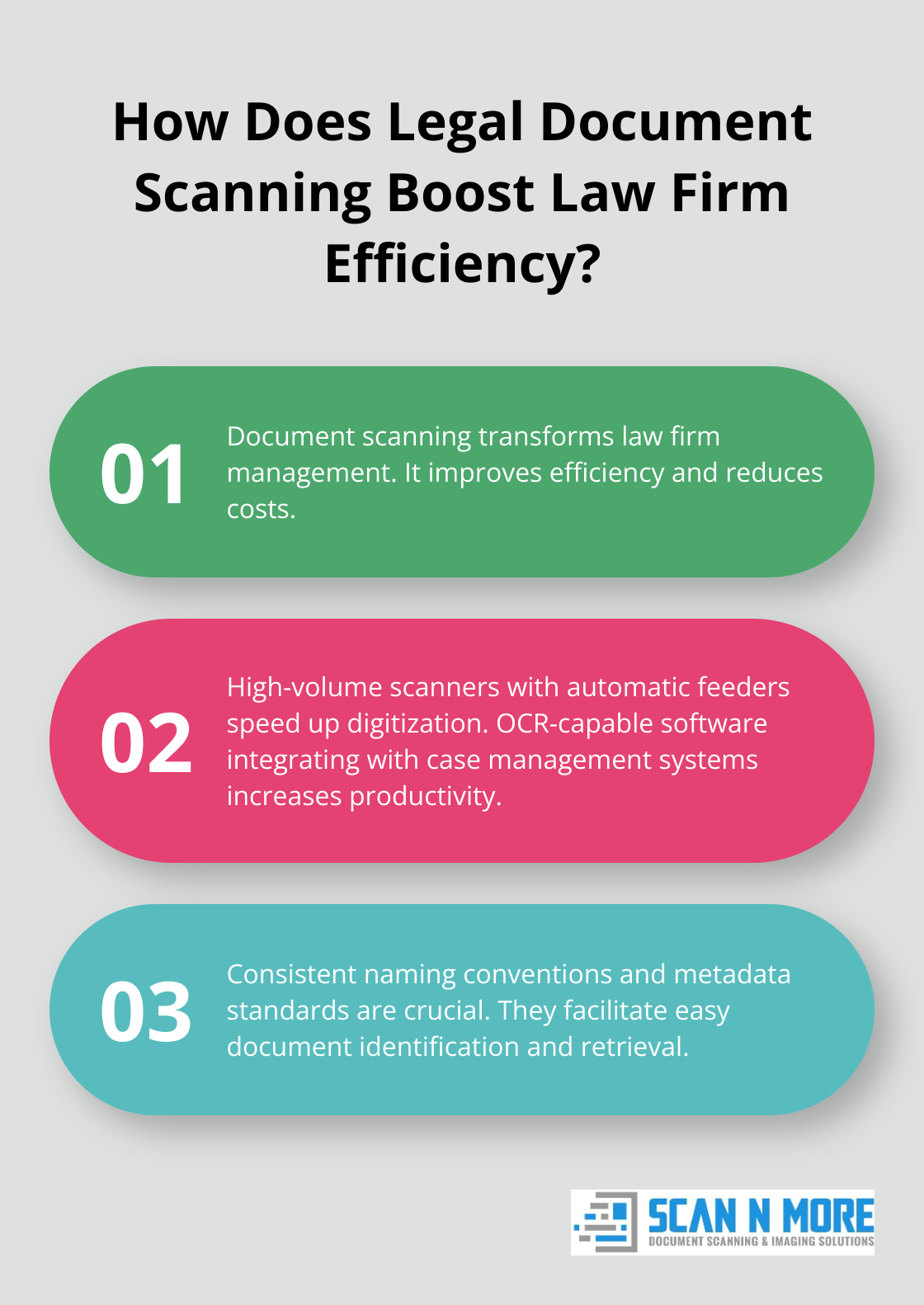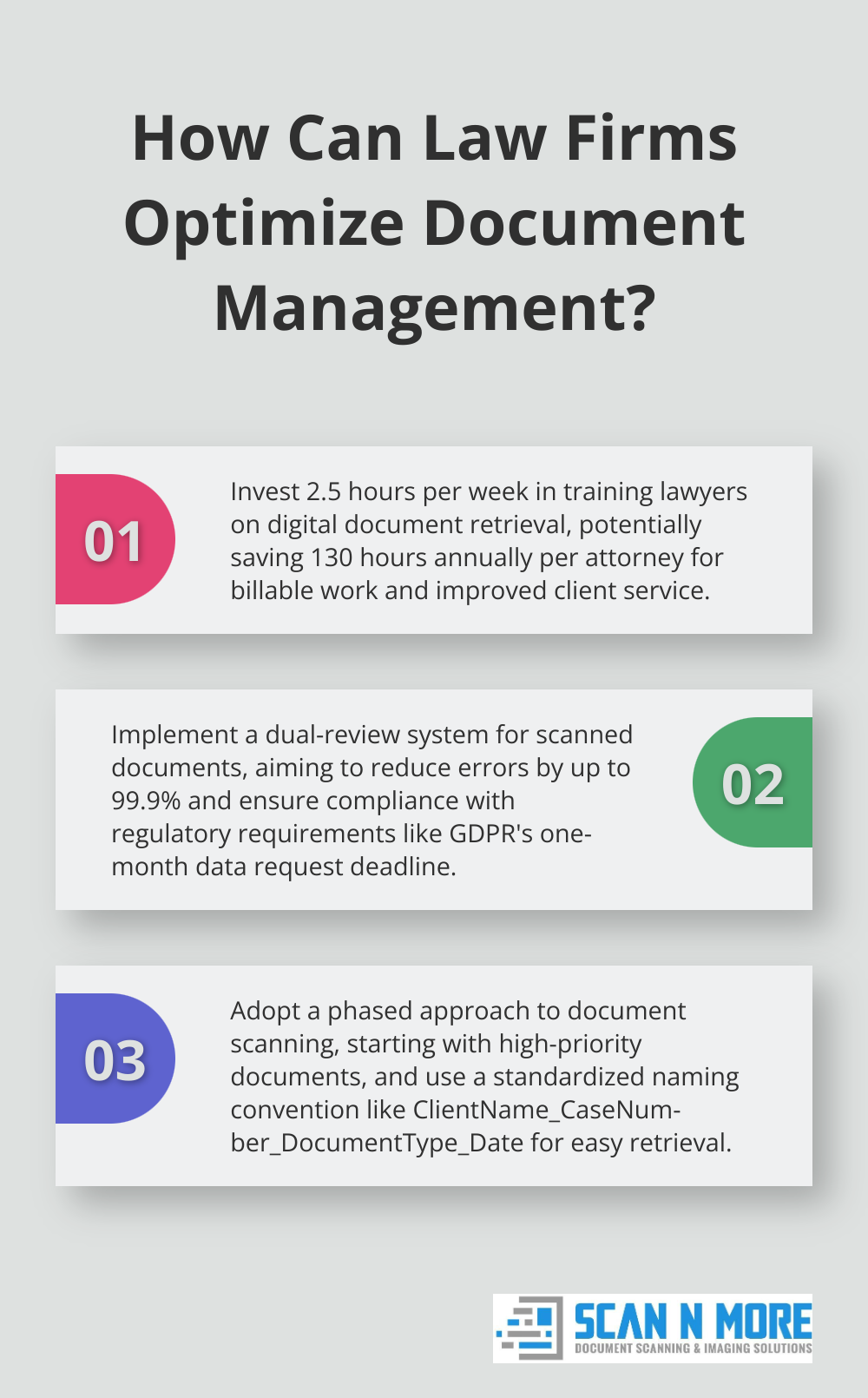Legal document scanning services have revolutionized the way law firms manage their paperwork. At Scan N More, we’ve seen firsthand how this technology transforms legal practices.
Efficient scanning solutions not only improve accessibility and security but also ensure compliance with regulatory requirements. In this post, we’ll explore the key features and best practices for implementing a robust legal document scanning system.
Why Legal Document Scanning Matters
Legal document scanning transforms law firms. It’s not just a trend; it’s a necessity for modern legal practices. Let’s explore the concrete benefits that make digital document management indispensable.
Streamlined Access and Search Capabilities
Digital documents eliminate the need to search through filing cabinets. Lawyers can access files instantly from any location. The American Bar Association reports that firms using document management software save an average of 2.5 hours per lawyer per week in document retrieval time (equivalent to 130 hours annually). This time savings allows attorneys to focus more on client service and billable work.
Fortified Security and Disaster Preparedness
Paper documents face risks of theft, fire, and natural disasters. Digital files, when properly secured, offer superior protection. A Gartner report highlights the importance of data security: 93% of companies that experience a major data loss go out of business within five years. Law firms must prioritize digital document security to avoid becoming part of this statistic.
Meeting Regulatory Requirements Head-On
The legal industry must adhere to strict regulatory compliance. Digital documents simplify this process. For example, the GDPR requires organizations to provide individuals with their personal data within one month of request. Searchable digital files make this task manageable rather than overwhelming.
Slashing Costs, Boosting Bottom Lines
Physical document storage drains resources. According to PricewaterhouseCoopers, businesses spend an average of $20 in labor to file every document and $120 to search for each misfiled document. Digital storage significantly reduces these expenses. Some law firms have cut their document storage costs by up to 75% in the first year after digitization.
Enhancing Collaboration and Productivity
Digital documents enable real-time collaboration among team members, regardless of their location. This capability proves especially valuable for firms with multiple offices or remote workers. Lawyers can simultaneously review and edit documents, accelerating case preparation and improving overall productivity.

The benefits of legal document scanning are clear and quantifiable. For law firms aiming to thrive in the digital age, embracing this technology is not just smart-it’s essential. As we move forward, let’s examine the key features that make professional legal document scanning services stand out.
What Makes Professional Legal Document Scanning Stand Out?
Professional legal document scanning services offer a range of features that set them apart from basic scanning solutions. These advanced capabilities transform how law firms and legal departments manage their documents.
High-Resolution Scanning for Clarity
The cornerstone of effective legal document scanning is high-resolution output. Advanced scanners capture documents at 600 DPI or higher. This level of detail preserves even the finest print and intricate details on legal documents. Footnotes on contracts or handwritten notes on case files remain crisp and legible when digitized.
OCR Technology: Turning Images into Searchable Text
Optical Character Recognition (OCR) technology transforms scanned images into searchable text. This feature revolutionizes document management for legal professionals. AI-based document review can help law firms reduce costs by up to 70%. This efficiency gain translates to more billable hours and improved client service.
Maintaining a Secure Chain of Custody
Security is paramount in legal document handling. Professional scanning services implement rigorous chain of custody procedures. At every step (from pickup to delivery), documents are tracked and accounted for. This level of oversight meets legal and ethical obligations. The American Bar Association emphasizes the importance of such measures in its guidelines for information security.
Rigorous Quality Control Measures
Quality control in document scanning extends beyond mere image clarity. It involves multi-step verification processes to ensure accuracy and completeness. For instance, some services employ a dual-review system where two separate operators check scanned documents. This approach reduces errors by up to 99.9%, according to industry benchmarks.
Seamless Integration with Existing Systems
The true value of scanned documents lies in their integration with existing document management systems. Professional scanning services offer compatibility with popular legal software platforms. This integration allows for immediate indexing and filing of scanned documents, which streamlines workflows. Altman Weil’s survey indicates that law firms leveraging integrated document management systems see a 20% increase in overall productivity.

Professional legal document scanning creates a robust, secure, and efficient digital ecosystem for legal practices. These key features transform document management processes, which leads to improved efficiency, reduced costs, and enhanced client service. The next section will explore best practices for implementing these scanning solutions effectively in your legal practice.
How to Implement Legal Document Scanning Effectively
Implementing a legal document scanning solution requires careful planning and execution. This process transforms document management for law firms, leading to improved efficiency and reduced costs. Here’s how to make this transition smooth and effective.
Create a Comprehensive Scanning Strategy
A successful implementation starts with a thorough assessment of current document management needs. Identify which documents require immediate scanning and which can be digitized over time. A phased approach allows for adjustments and minimizes disruption to daily operations.

Set clear, quantifiable goals for your scanning project. These might include reducing physical storage space or improving document retrieval times. Such specific targets provide a clear direction for the implementation process.
Select Appropriate Scanning Equipment and Software
The right tools play a critical role in the success of your scanning initiative. High-volume scanners with automatic document feeders can process large volumes of documents, significantly speeding up the digitization process. For firms handling sensitive documents, scanners with built-in security features (like encryption) are essential.
Choose software solutions that offer OCR capabilities and integrate with your existing case management system. This integration can lead to substantial productivity gains.
Standardize Naming Conventions and Metadata
Consistent naming conventions and metadata standards form the backbone of an efficient digital document system. Develop a clear, intuitive naming structure that allows for easy identification and retrieval of documents. For example, use a format like “ClientName_CaseNumber_DocumentType_Date.”
Define key metadata fields such as document type, date, author, and case number. Including metadata fields for each document facilitates effective searching and organization.
Invest in Staff Training
The success of your scanning initiative depends heavily on proper staff training. Allocate sufficient time and resources to ensure all team members understand the new processes. Law firms that invest in comprehensive training often see a faster adoption rate of new document management systems.
Create detailed scanning procedures and guidelines. These should cover everything from document preparation (removing staples, smoothing creases) to quality control checks. Consider designating “scanning champions” within your team to provide ongoing support and troubleshooting.
Monitor and Refine the Process
Implement a system to monitor the scanning process and its outcomes. Regular audits can help identify bottlenecks or areas for improvement. Use metrics such as scanning speed, error rates, and user satisfaction to gauge the effectiveness of your new system.
Be prepared to refine your processes based on feedback and performance data. This might involve adjusting workflows, upgrading equipment, or providing additional training to staff. Continuous improvement ensures your document scanning solution remains effective and aligned with your firm’s evolving needs.
Final Thoughts
Legal document scanning services transform modern law firms. These services enhance efficiency, security, and client service through improved accessibility, regulatory compliance, and cost savings. High-resolution scanning, OCR technology, and secure procedures revolutionize document management for legal professionals.

A comprehensive strategy and the right tools ensure a smooth transition to digital document management. Firms must select appropriate equipment, establish clear naming conventions, and train staff effectively. These steps improve productivity and reduce operational costs significantly.
Scan N More offers professional document scanning services tailored for legal professionals. Our expertise and technology help law firms transition to a digital environment securely. Legal document scanning services (like ours) position firms to better serve clients, adapt to regulatory changes, and compete in the digital legal market.
